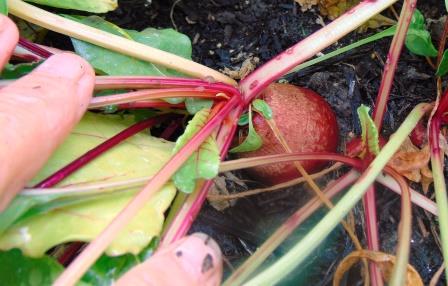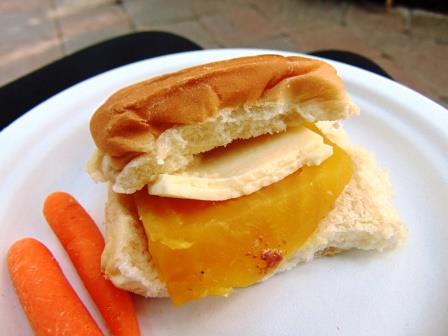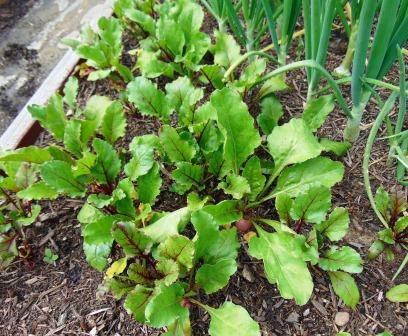 2018 has been declared the “Year of the BEET” by the National Gardening Bureau. I adore beets, pickled, roasted, in soups and salads, so I was delighted to hear the news. I’d already decided to grow more beets this coming year, so I began studying the catalogs for new (to me) varieties. Surprisingly, I received a new catalog last week from (another surprise!) an Indiana business! Having been immersed in the Hoosier horticultural scene for over 40 years, I thought I knew all the growers, garden centers, suppliers, etc. According to their catalog, E & R has been a seed supplier and garden store since 1995! I can’t imagine how we’ve missed each other.
2018 has been declared the “Year of the BEET” by the National Gardening Bureau. I adore beets, pickled, roasted, in soups and salads, so I was delighted to hear the news. I’d already decided to grow more beets this coming year, so I began studying the catalogs for new (to me) varieties. Surprisingly, I received a new catalog last week from (another surprise!) an Indiana business! Having been immersed in the Hoosier horticultural scene for over 40 years, I thought I knew all the growers, garden centers, suppliers, etc. According to their catalog, E & R has been a seed supplier and garden store since 1995! I can’t imagine how we’ve missed each other.
The third suprise was, that of all the dozens of catalogs I’ve received so far, E & R carries the largest number of beet varieties, an amazing 25! Many were the old favorites I’ve always grown, reliable and productive, like “Detroit Red,” “Bull’s Blood” and “Ruby Queen” but there were many unfamiliar names that I’m eager to try. To space out the harvest, there are early varieties such as “Early Wonder,” “Robin,” “Detroit Supreme” and “Red Ace,” all around 50 days from seeding to harvest.
Mid-crop varieties (55-60 days) include “Crosby’s Egyptian” and “Merlin.” For later crops that are very heat tolerant, they suggested “Falcon” all of which I plan to grow.
For those that intend to slice beets, “Cylindra” is a good choice because instead of growing balls, in 60 days it grows in a long cylinder shape that provides many more inches of beet per plant. New to me was “Rodina,” an improved cylinder-shaped beet that grows 6″ long, dark red beets that is disease resistant.
“Chioggia” has been available for years, and I enjoy growing it for it’s “target” slices of red and white circles. It’s an old Italian heirloom with excellent flavor. “Chioggia Guardsmark” takes a bit longer to mature, but it’s colored circles have more contrast and it’s more bolt-resistant.
All of the beets mentioned above have that deep red pigment that is great for coloring eggs, dying yarn, making a temporary ink, or Indian war paint, but sometimes that deep red stain isn’t the look desired.  For a real change, there are non-red beets. Golden Detroit and Touchstone Gold have been around for a while, and both are great for using in salads, beet sliders (shown above), or soups when the red “bleeding” is undesirable. If you’ve never made beet sliders, they are delicious, with or without cheese, and just a smear of horseradish sauce. Another option is White Albino, a unique white beet that E & R reports is good for pickling or frying. Frying? I’ve never fried beets, so that’s something I’ll have to try.
For a real change, there are non-red beets. Golden Detroit and Touchstone Gold have been around for a while, and both are great for using in salads, beet sliders (shown above), or soups when the red “bleeding” is undesirable. If you’ve never made beet sliders, they are delicious, with or without cheese, and just a smear of horseradish sauce. Another option is White Albino, a unique white beet that E & R reports is good for pickling or frying. Frying? I’ve never fried beets, so that’s something I’ll have to try.

Generally, if I want beet greens for salads, it happens when I thin rows. However, for market gardeners or those who want a larger, more consistent quantity of beet greens there are now beet varieties developed especially for that purpose. “Fresh Start” is a new hybrid baby leaf variety with attractive dark red stems and veins and bright green leaves that is especially disease resistant. “Kestral” is even faster at 22 days, disease resistant, and also a good choice for baby beets as well as baby greens. “Lutz Green Leaf” has a pink stem with 18″ leaves that are good for salads or cooking, and the 3″ beet is excellent for winter storage. “Lutz” also comes in a red stem and white stem option. And the old favorite, Bull’s Blood has gorgeous deep red leaves that add color and flavor to salads.
Also included are Sugar Beets. That made me smile at the memory of the year (and only one year!!!) on the homestead that I grew sugar beets and made “sugar.” It was not a great success, and when I calculated the amount of firewood it took to cook down the brownish syrup to unappetizing crystals, and the amount of my time absorbed it was never attempted again.
The same with “Red Fodder” beets which produce huge (think 20 pound footballs!) roots for animal fodder. I grew those on the homestead one season as well, and although horses, cows, hogs and goats are supposed to love them, ours didn’t even when I spent hours axing them into smaller, manageable pieces.
In addition to the offerings of E&R, other catalogs offer additional choices: Red: Kestrel, Boro, Pablo, Babybeat, Boltardy, Red Cloud, Paonazza d’Egitto, Lutz Winter Keeper, Sweet Dakato Bliss, Zeppo, Moneta, and Crapaudine. Golden: Boldor. White: Avalanche, Detroit White. Especially for greens: MacGregor’s Favorite, Early Wonder Tall Top. For storing: Pablo, Lutz Winter Keeper. Most catalogs offer a rainbow blend, which allows growers to try a variety of beet colors and shapes without having to purchase a packet of each.
Beets are extremely easy to grow, needing only average soil, adequate, consistent moisture, and sunshine. Some varieties tend to push their shoulders above the soil, and may need to be “hilled” slightly (that is, soil pulled up around their stems to cover the ball) to keep their shoulders smooth. Keep in mind that each beet seed is a “fruit” containing more than one seed, so even with good initial spacing, some thinning may be required. I’ve found that soaking the seed overnight helps speed germination. Beets are also one of the crops that I start in plugs indoors to give a jump-start on the season. Sowing them every two-three weeks throughout the season provides continuous successive crops, and provides a steady supply of pre-started, quick-to-mature plants that I can pop into the soil wherever other crops come out as harvested. Plant the storage varieties last, and properly stored (just above freezing with adequate moisture) they will keep for several months.
Although some varieties are touted for their disease resistance, beets seem to have few problems, especially if crops are rotated and harvested when ready. Some of the older varieties can tend to become woody if not harvested in a timely manner, but newer varieties have overcome that tendancy.
Having grown up in a “waste not, want not” lifestyle that I still follow, rather than pour the liquid from canned beets (plain, not pickled…pickled beet juice is of course used to pickle hard boiled eggs) down the drain, use it to make a colorful, tasty sangria! Thinnings that have marble-sized beets are wonderful just tossed into a skillet with a little butter and sauteed just until the greens are nicely wilted and the tiny beets are warmed. A bit of salt & pepper, and you have a meal! A splash of vinegar makes it even better.
Hopefully this inspires you to give more space to beets, a versatile vegetable that is fun and easy to grow, makes good use of garden space, and since all parts are edible, there is no waste! Pick a color and get growing!

I need to do this again. The one time I grew beets they were the best tasting ever. Maybe this is the year to do it again.
LikeLike
Do give them another try. They are so good for you, and so versatile and forgiving of neglect. You’ll be happy you grew them, and there are so many great choices nowdays.
LikeLiked by 1 person
I grew white ones for the first time this year because Inwas fed up with everything in the kitchen being stained by the red ones. They tasted just as usual but my brain could not reconcile the colour and taste! Every time I ate some it was a surprise. A friend grew yellow ones and my brain reckoned they were near enough red to be OK so this year I have ordered yellow seed. Strange things brains!
LikeLike
Strange indeed. I felt the same with my first encounter with golden beets, but I love them now, except pickled…my brain just won’t accept that big a change!
LikeLike
Your gardening enthusiasm is contagious 🙂 My winter vegetable seedlings all went bust and I am clenaing out my raised beds again. I was going to wait till spring for tomatoes and peppers, etc. but now maybe I will give some other veggies a try 😀
LikeLike
I wish I could get my hands in the soil. It’s buried under snow and our temperatures are record lows over an extended period….minus 14 degrees F this morning, even with sunny skies. Count your blessings! And get digging!
LikeLike
Love pickled beetroots in salad and burgers…
LikeLike
I only grow two or three varieties. Chioggia looks pretty, but I didn’t like its flavour much. I do love Burpee’s Golden and Golden Detroit though, especially roasted. Beetroot is good for high blood pressure I was told a few days ago.
LikeLike
Thanks for letting others know that 2018 is the Year of the Beet! We are super excited because as you mentioned they are easy to grow, good for you, come in lots of different colors, and the entire plant can be used in delicious and healthy recipes and smoothies! For more info –
https://ngb.org/year-of-the-beet/
LikeLike
Enjoyed this post, delighted to hear about the salad beets- all the best, Hugh
LikeLike
Great post about beets. My mom and I grow them every year as she’s a big fan of them too. I will be sharing this info. with her.
LikeLike
Hi Carolee. I’m a great fan of the Boldor yellow beets. Do you or have you had success with multisowing beets?
LikeLike
Multisowing? Not sure of the definition. I do succession plantings so I have beets at various stages throughout the season. I do a couple of big sowings so I can make pickled beets to can. One single beet seed does contain the possibility to make several plants so I try to plant them with spacing and then thin them as baby greens. Does any of that answer your question?
LikeLike
Hi carolee. It’s a new concept to me. Here’s a video illustrating it. https://m.youtube.com/watch?v=iWUwS9P_GOs
LikeLike
Ok. Yes, I do that all the time…just a new term for it, at least to me. I do start my first crop of beets, sprinkling 1 or 2 seeds in a plug. Since a beet seed can sprout 1-4 plants, I usually try for 1 seed. Just planted my first tray a few days ago and put 2 in because the seed is old and may not germinate as well. The plugs go into rows when the weather settles. If there are more than 3-4 plants, I usually divide the plug in half and plant each half separately. I do it with cipollini, lettuce, spinach also. It really does save a lot of time and gives crops a jump start. Did you notice he can’t count…kept saying 3-4, when I counted 6-7 kale babies in most plugs! Just thought that was funny.
LikeLike
Haha! What I can’t seem to wrap my head around is how a clump of 3-4 beets grown together will yield as much as a beet grown singly. Saves space and time, but yield??? Thanks for taking the time to respond 🙂
LikeLike
I generally harvest young ones for greens as they grow, or let them get about 1″ across and then cook them whole greens & all with a bit of butter, and sometimes a splash of vinegar. So there’s only 1 left per space to mature for roasting or slicing. I’m not sure the yield is as great overall, but it does give me beets to use earlier than just seeding them directly into the ground. And if I direct seed, there’s still often a cluster.
LikeLiked by 1 person
My mouth is watering. Sorry to bother you so much, I’ll try to make this my last question: At what size do you start peeling beets? Again, thanks for your responses.
LikeLike
When they are bigger than an inch across. You are definitely not a bother. We learn by observation, trial and error, and asking questions…all good things.
LikeLiked by 1 person